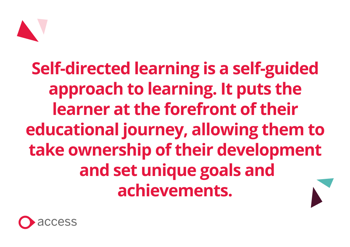What is Self-Directed Learning, and how can it transform workplace learning?
Self-directed learning is a self-guided approach to learning which makes the most of the variety and options available to those looking for different methods of learning. With the increase in employees actively seeking out their own learning endeavours and organisations recognising the value of nurturing this culture, self-directed learning should be an integral part of every organisation's L&D strategy.
In this article, we will discuss self-directed learning theory, the benefits of self directed learning in the workplace and offer three self-directed learning strategies that your organisation can implement.
- What is self-directed learning?
- What is the theory behind self-directed learning?
- How does self-directed learning benefit employees?
- How does self-directed learning benefit managers?
- How does self-directed learning help L&D teams?
- Implementing self-directed learning in the workplace
- Overcoming challenges and barriers
- Reap the benefits of self-directed learning in the workplace with the help of Access Learning
What is Self-Directed Learning?
Imagine having the freedom to drive your own learning journey, just like navigating your favourite streaming service.
Self-directed learning is a self-guided approach to learning. It puts the learner at the forefront of their educational journey, allowing them to take ownership of their development and set unique goals and achievements.
While the responsibility is shifted to the learner, L&D teams must also support them on their journey with suitable resources and a cultural approach to this type of learning.
Employees can benefit from:
- autonomy of choice
- self-motivation
- efficient learning methods
Organisations can benefit from:
- elevated employee performance
- enhanced engagement and staff retention
- continuous learning

What is the theory behind Self-Directed Learning?
Traditional learning often takes a one-size-fits-all approach, with instructors dictating the curriculum. Self-directed learning theory flips this script, placing employees at the centre of their learning journey – but where did it come from?
It can be traced back to the work of Malcolm Knowles, who formalised it in his 1975 book, "The Adult Learner: A Neglected Species". Knowles' self-directed learning theory underscores the significance of this approach, aligning with the first principle of andragogy:
"Adults need to be involved in the planning and evaluation of their instruction."
This principle recognises that adults can identify their own learning needs. However, in a workplace setting, they can’t do this without support. It's the responsibility of Learning and Development departments to create a learning environment that not only acknowledges this capacity but also equips employees with high-quality tools and resources that are easily accessible.

How does self-directed learning benefit employees?
One of the top three reasons to spend more time learning in 2024, according to the LinkedIn Workplace Learning Report, is “if it is personalised for my interests and career goals.” This shows just how beneficial learning can be if it is tailored to each individual.
Let’s explore how it can help empower and develop employees in more detail:
Personal Growth and Development
A self-directed learner will take charge of their personal and professional growth. By having flexibility in learning pace and content, employees can focus on areas of interest and learn at their own speed. This fosters a sense of accomplishment and builds self confidence.
Supports Career Development
When offered a variety of different learning opportunities, employees can take initiative and identify skills and knowledge relevant to their current or desired job roles. This targeted learning demonstrates a strong commitment to growth and positions them for advancement within the company.
Encourages a healthy work-life balance
If an employee integrates different types of learning into their daily routine of their own volition, it empowers them to take ownership of their development. This sense of agency can lead to improved work-life balance.
How does self-directed learning benefit managers?
While self-directed learning provides a lot of advantages to employees, it’s important to look at how it can also help managers. Below are four benefits of self-directed learning in the workplace which impact management and team leaders:
Increases employee engagement and ownership
By encouraging a self-directed learner to develop at their own pace, managers can increase employee engagement. Tailored learning experiences will lead to higher motivation and a happier workforce overall. It will also likely reduce staff turnover and increase retention rates.
Encourages upskilling initiatives
When an employee takes ownership of their learning, they are more likely to proactively seek out opportunities to upskill with the help of the internal resources available to them. From a management perspective, this can create a more dynamic team who strive to learn more, which can encourage internal promotions and movement.
Leverages internal resources
Self-directed learning encourages employees to explore the wealth of resources already available within the company. By utilising these internal resources, managers can save on external training costs and ensure employees are learning with materials tailored to the company's specific needs and processes.
Drives innovation and adaptability
Self-directed learning encourages employees to stay up to date with industry trends, new technologies, and best practices on their own initiative. This can result in a more innovative and adaptable workforce, better equipped to respond to changes in the market and take advantage of new opportunities.
How does self-directed learning help L&D teams?
The shift towards self-directed learning empowers both learners and L&D professionals, leading to a more effective and engaging learning environment. Here's how self-directed learning specifically benefits L&D teams:
Reduce time spent assigning and managing training
When an employee seeks out their own learning opportunities, it takes the onus off L&D managers to assign, manage and track the training. This reduction in time spent on administrative tasks allows them to focus on strategic decision-making instead.
Cultivates a learning culture in the workplace
Employees are more likely to see themselves as active participants in their own development. This fosters a culture of continuous learning within the organisation, which can help alleviate some of the demand from L&D teams to encourage this kind of behaviour, as it will be embedded through this type of learning.
Offers anonymous learning
Some employees may feel hesitant to disclose their skill gaps or learning needs in a traditional training environment. Self-directed learning platforms can offer anonymity, encouraging participation from individuals who might otherwise be reluctant to seek out development opportunities. This allows L&D teams to gain a more comprehensive understanding of the overall skill needs within the organisation.
Identifies skills gaps
By encouraging self-directed learning, L&D teams can gain insights into the skills and knowledge gaps within the organisation. Employees' choices of what to learn can provide valuable data on areas where additional training or support may be needed, helping teams tailor development programs more effectively, which in turn aids in closing the digital skills gap.
Speak to one of our learning experts to find out more about Self-Directed Learning - powered by Bookboon.
Implementing self-directed learning in the workplace
Now we have covered the benefits of self-directed learning in the workplace, let’s look at three strategies on how to implement it successfully.
Overcoming challenges and barriers
While Self-Directed Learning Theory can offer organisations a number of benefits, there may be challenges that are presented when it comes to implementing this way of learning. Let’s explore three barriers and how your organisation can overcome them.
Resistance to change
If your workforce has not come across self-directed learning before, it is natural that some may be resistant to the shift. You can help tackle this by:
- Addressing concerns and misconceptions
- Building a compelling case for self-directed learning
- Finding out what type of learning your employees want to do
Maintaining accountability and tracking progress
Maintaining accountability is crucial for successful self-directed learning, both for the organisation and for the individual learner. Here's how to achieve it:
- Implement effective tracking and reporting systems
- Encourage self-assessment and reflection
Utilising a robust Learning Management System which supports different learning methods.
Ensuring equity and inclusivity
While self-directed learning offers a powerful path for individual growth, it's crucial to ensure all employees have an equal opportunity to thrive in this environment. Ensure you are:
- Providing equal opportunities for all employees
- Addressing diverse learning needs and preferences with accessible content
- Having conversations with your employees about their learning preferences and making sure these needs are met

Reap the benefits of self-directed learning in the workplace with the help of Access Learning
As we have covered within this article, Self-Directed Learning Theory is a way of working which gives the learner the opportunity to seek their own learning opportunities.
Empowering your employees through self-directed learning cultivates a culture of ownership, continuous learning, and ultimately, a more engaged and productive workforce. At Access Learning, we are passionate about helping organisations unlock the full potential of their employees.
Find out how our Self-Directed Learning solution can help you to tailor your learning to the preferences of your employees and create a workforce that takes ownership of their learning.
Explore our Self Directed training solution today!
There are many ways to find out more about Bookboon and how our engaging, learn on demand content can transform the learning culture in your business.

Speak to an expert
Chat with one of our learning experts and find out how Bookboon Professional Development training can be tailored to meet the needs of your business, regardless of size.

Schedule a live demo
Relax and let one of our learning experts showcase the capabilities of Bookboon and find out how it can help transform your organisation.

Discover more Digital Learning Solutions
Access Learning contains all the powerful tools you need to take your organisation to the next level.
